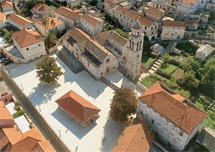 Blato is a municipal centre with about 4,000 inhabitants, reached by the main island road from Smokvica through the forests in the middle of the island Korcula. The village was amphitheatrically built on several hills around a small central valley. A long avenue of lime trees called Zlinj runs through it, along which public buildings were more recently built: school, hotel, bank, shops, municipal building, medical centre etc.
Blato is a municipal centre with about 4,000 inhabitants, reached by the main island road from Smokvica through the forests in the middle of the island Korcula. The village was amphitheatrically built on several hills around a small central valley. A long avenue of lime trees called Zlinj runs through it, along which public buildings were more recently built: school, hotel, bank, shops, municipal building, medical centre etc.In order to provide you with the best online experience this website uses cookies. Delete cookies
By using our website, you agree to our use of cookies. Learn more
Privacy statement serves us for protection of privacy of our users. You can look at iKorculainfo.com pages for free, without any commitment of revealing your identity or leaving any kind of your private data. In case that you decide to use our services, it's necessary to leave us your personal data, so that we could complete your reservation and to lease asked service. Your personal data remains protected. We assure you that we are collecting only information that we need to complete our procedure of reservation of our service. In that process we are using only information that we receive directly from you.
Use of collected information
We are not going to use collected information for purposes that are not mentioned in this statement. Your personal data, travel agency "Vakance" does not sell, trade, rent or give to third parties, unless it's necessary for the procedure of the realization of selected service. |







